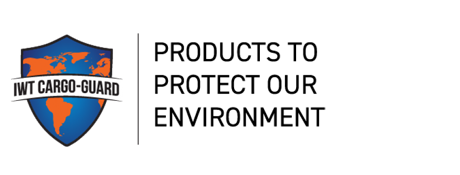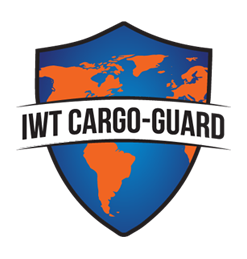ENVIROGRID
The EnviroGrid Cellular Confinement System is a lightweight, expandable, three-dimensional honeycomb grid manufactured from durable high density polyethylene (HDPE). The geocells can be filled with various types of infills, such as soil with vegetation, aggregate, concrete, or a combination thereof. EnviroGrid is also a cost-effective and environmentally friendly solution for erosion control, earth retention and load support projects.
Specification
EnviroGrid geocells are available in cell heights of 3”, 4”, 6”, and 8”. In addition, they are available in a perforated or solid wall construction that can be either smooth or textured. Custom sizes and colors are also available. Using woven geotextiles and geogrids in conjunction with EnviroGrid can significantly reduce the amount of fill required or provide reinforcement of the system.
Anchors
EnviroClip™ Twist Anchor clips are helical anchors that clip to the side of the perforated wall. They secure the Envirogrid cellular confinement system in place without the use of heavy rebar or pipe. In addition, they are suitable for use in a variety of soils. Enviro Clips™ install quickly and easily with only a standard electric drill. Individual panel sections attach together with a pneumatic stapler or an EnviroLock tie.
For more information on the EnviroGrid cellular confinement system please contact our sales office at 609-971-8810 . We welcome the opportunity to be of service.
The EnviroGrid Cellular Confinement System is a lightweight, expandable, three-dimensional honeycomb grid manufactured from durable high density polyethylene (HDPE). The geocells can be filled with various types of infills, such as soil with vegetation, aggregate, concrete, or a combination thereof. EnviroGrid is also a cost-effective and environmentally friendly solution for erosion control, earth retention and load support projects.
Specification
EnviroGrid geocells are available in cell heights of 3”, 4”, 6”, and 8”. In addition, they are available in a perforated or solid wall construction that can be either smooth or textured. Custom sizes and colors are also available. Using woven geotextiles and geogrids in conjunction with EnviroGrid can significantly reduce the amount of fill required or provide reinforcement of the system.
Anchors
EnviroClip™ Twist Anchor clips are helical anchors that clip to the side of the perforated wall. They secure the Envirogrid cellular confinement system in place without the use of heavy rebar or pipe. In addition, they are suitable for use in a variety of soils. Enviro Clips™ install quickly and easily with only a standard electric drill. Individual panel sections attach together with a pneumatic stapler or an EnviroLock tie.
For more information on the EnviroGrid cellular confinement system please contact our sales office at 609-971-8810 . We welcome the opportunity to be of service.
APPLICATIONS
Soft, unstable soils create serious issues in unpaved areas such as access roads, parking lots, paths and driveways. EnviroGrid offers an effective soil stabilization solution since it confines the base materials to prevent lateral movement. The geocells provide horizontal and vertical confinement of the entire depth of the base layer, significantly reducing pressure and providing subgrade support. Since each cell within a section connects to adjoining cells, each section of EnviroGrid acts as a large mat or pad distributing applied loads over a large area.
EnviroGrid also allows the use of lower quality aggregates found locally, which eliminates the need to import better or more material. In addition, filling compact sections of EnviroGrid with sandy soil can replace truckloads of crushed stone, other granular fill, asphalt or concrete. Additionally, the base material can be more open graded, dramatically improving drainage of the system and increasing life expectancy.
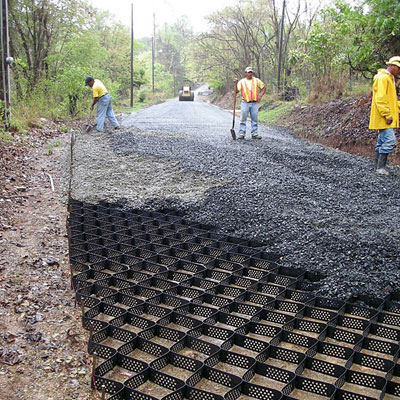
Soil particles on slopes are susceptible to being detached and carried away with concentrated runoff streams, forming rills and gullies. Over time, the slopes become steeper and less stable, creating an environmental and safety issue. Traditional methods of stabilizing slopes to prevent erosion use a cover material such as granular fill, vegetation and concrete. However, these materials alone may not be sufficient to withstand hydraulic forces or steepness of the slope.
Design of EnviroGrid cellular confinement systems for slopes requires analysis of several site characteristics. Length, height and angle of the slope and the failure angle of existing fill on the slope are important factors in determining the appropriate cell depth and anchoring design.
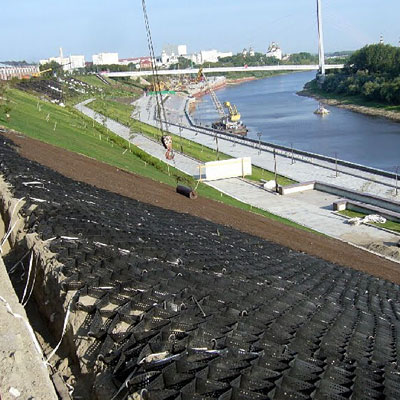
Retaining wall structures are becoming more necessary as construction encounters rough terrain, steep slopes, and embankment reinforcement. Changes-in-grade also present obstacles for roads and other development requiring flatter, more usable land. Standard methods of concrete reinforced retaining walls rely entirely upon internal strength and rigidity. They are also costly to build, vulnerable to cracking and unattractive to the environment. An EnviroGrid retaining wall or steepened slope can be constructed wherever a rapid change of grade is desired.
On projects where structures are built with fill material, it is more cost-effective to use EnviroGrid in conjunction with a geogrid. The geogrid acts as a tieback in the reinforced zone. EnviroGrid assumes the role of the facing element, such as concrete blocks in a modular block retaining wall. Unlike modular block, EnviroGrid is flexible and easy to handle. Planting with grass or shrubbery gives the face a natural look. In cut situations, the exposed face is unstable due to the removal of the soil holding it in place. As a result, replacing some of this weight is necessary to stabilize the area. Stacking and filling EnviroGrid panels creates a near vertical, heavy, reinforced mass or retaining wall.
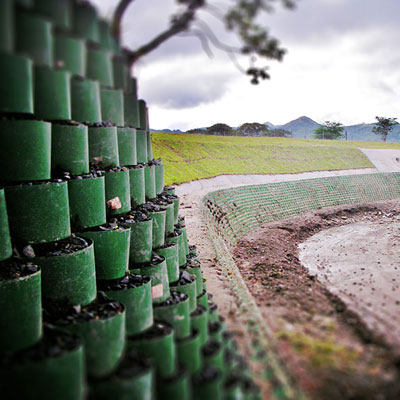
Channels are often subject to debilitating erosion due to water contained by the channel walls. Depending on the water flow velocity as well as frequency and degree of stormwater runoff, severe hydraulic stresses upon the channel walls pose significant dangers to the system. In addition, extended water flow endangers standard soil and grass lined channels. Even low to moderate forces can gradually remove particles on channels with loose aggregate. Poured concrete walls can only perform effectively with construction joints in order to avoid rigidity and lessen the danger of compromise from base material displacement. The system must also be resistant to erosion and stable under the slope geometry and hydrostatic uplift forces.
EnviroGrid cellular confinement systems offer a strong yet flexible solution to contain material while minimizing the erosive forces to the channel slope or bottom. However, multiple considerations are necessary to achieve a safe, environmental, and durable channel system:
- Channel walls must be somewhat flexible to ensure integrity in the face of localized deformations from seasonal factors and sub-base void formation. However, the system must also be rugged and durable to avoid degradation and uplift from hydraulic forces that are present.
- System permeability is desirable in some instances to allow natural drainage. A pervious channel wall relieves hydrostatic uplift forces while stabilizing the system.
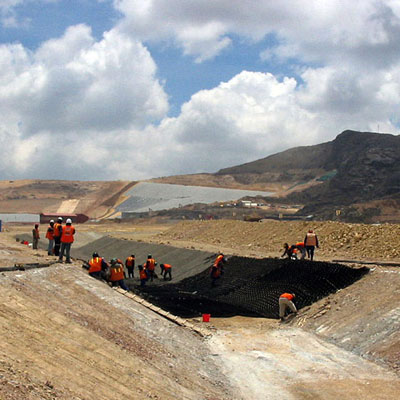
Disclaimer: These guidelines are for informational purposes only and are intended as illustration or general information only and are not intended as a guarantee or warranty. IWT assumes no responsibilities in connection with the use of this information.
